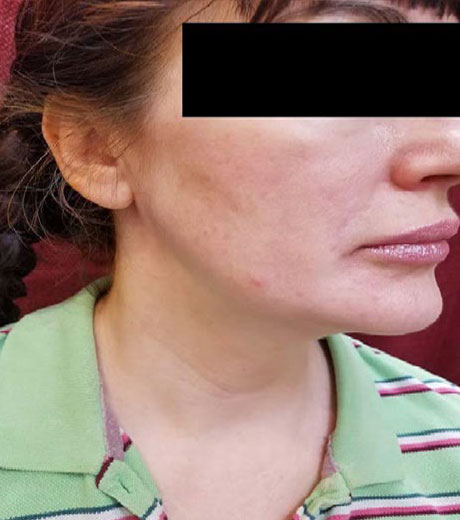Before
Threads Face Lift


After
We offer FREE consultation
What you need to know about thread lifts
Until recently, the only way to address problems caused by facial skin laxity – such as jowls and drooping cheeks – was facelift surgery. After all, while skin resurfacing treatments can help to restore some degree of firmness, once loose skin is present, only a scalpel can truly remove it.
However, while the approach of relying on injectable compounds and skin resurfacing until facelift surgery becomes absolutely necessary works for many patients, not everyone is willing or able to have surgery. If you’re in this group, you’ll be happy to know that a new type of procedure has been developed to fill in the gap between noninvasive facial rejuvenation and facelift surgery – the thread lift.
What is a thread lift?
A thread lift is a type of procedure wherein temporary sutures are used to produce a subtle but visible “lift” in the skin. Instead of removing the patient’s loose facial skin surgically, the cosmetic surgeon simply suspends it by stitching up portions of it. This has the effect of pulling the skin back slightly and therefore lifting and tightening the face. In addition to being ideal for lifting the skin, threads combat aging in another way: by provoking the body’s “healing response” and causing the body to direct large surges of collagen to treated areas. This is important because of the vital role collagen plays in the aging process.
Collagen helps support “growth factors” that greatly influences the condition of our skin. In addition to being used for wound healing, collagen helps to keep our skin strong, voluminous and supple. As we get older, our bodies gradually produce less and less collagen, which leads to an 80% reduction in skin thickness by about age 70. This loss of volume and strength is a large factor in the creation of excess skin and wrinkles. As the skin grows weaker, it’s no longer able to support the tissues beneath it adequately, meaning that gravity pulls it downwards and stretches it. Infusing the skin of the face with fresh collagen when the signs of skin laxity are still mild can help to both reduce looseness (by thickening and hydrating the skin) and prevent it from getting worse (by strengthening the skin).
In other words, this process provides ongoing and progressive rejuvenation for the facial tissues. Patients who have a thread lift for the purpose of stimulating collagen will notice a gradual improvement in their skin’s tone and firmness. While their threads are in place, the body’s healing response will be constantly activated because the body will want to “heal” the sutured areas and expel the sutures. The body is biologically programmed to react this way when it senses any foreign object present within the dermis. Fortunately, because the threads placed under the skin during a thread lift are so small, the patient will not feel any of this happening. Most people cannot feel their sutures at all once the skin has healed around them.
What are the advantages of having a thread lift instead of a facelift?
For many patients, the biggest advantage of having a thread lift rather than a facelift is the greatly reduced recovery time associated with thread lifts. When a patient has facelift surgery, he or she must be heavily sedated; as such, the patient must arrange for someone to drive him or her home from the hospital. Most facelift patients also require around the clock assistance from a caretaker for at least three days after they have surgery. Furthermore, if the patient still has children at home, childcare aid may also be needed. Facelift patients usually need to take one to two weeks off of work, too, in order to heal.
Recovery from a thread lift, on the other hand, is comparatively easy. Thread lifts can be performed under local, rather than general anesthesia, meaning that thread lift patients can drive themselves home and look after themselves immediately after having their procedure. While some patients will experience a little bit of soreness, redness and swelling after having a thread lift and therefore wish to take the rest of the day off, most can return to work immediately. Strong pain medication is seldom needed after having a thread lift, making it easier for patients to return to their normal routine. This procedure is therefore ideal for people who have children at home or those who have busy, demanding careers.
While thread lift recovery is not particularly intensive, patients will still have to take a few minor precautions while healing. It’s important to make sure that you don’t rub your face vigorously while cleansing it or applying moisturizer for at least a week after having threads placed. You should also try to prop your head up slightly so that you don’t roll over directly onto your face while sleeping.
Thread lifts are low risk, thanks to how noninvasive they are. There is virtually no risk of scarring, severe bruising, bleeding or other complications after having a thread lift. In rare cases, patients may experience irritation, infection or their sutures becoming visible under their skin. If this occurs, however, the sutures can simply be removed and the patient’s face will return to its prior state.
Finally, because thread lifts are much easier to perform than facelift surgery, they are much more affordable.
Advantageous though thread lifts are, it’s important for patients to maintain realistic expectations for this procedure. While thread lifts certainly produce visible changes, they will generally only lift the face by a few millimeters; as such, they create a more subtle and natural looking end result than facelift surgery. Thread lifts are therefore best suited to patients who are dealing with mild to moderate, rather than severe, signs of skin laxity.
The ideal thread lift candidate is usually in his or her late thirties to early fifties, whereas most patients over the age of about 55 will benefit more profoundly from facelift surgery. Thread lifts can, however, provide a facelift alternative for older patients who are unable to have surgery for medical reasons. Because thread lifts can be performed under local anesthesia, many people who have age-related conditions that make them ineligible for surgery (like high blood pressure, type two diabetes and cardiovascular disease) can safely have this treatment. If you have any outstanding health conditions, make sure to talk to your doctor about whether or not a thread lift might be right for you.
It’s important to understand that while no lifting technique can produce permanent results, facelift surgery will usually produce longer lasting results than a thread lift. The results of facelift surgery can last up to a decade, whereas a thread lift will generally last from one to three years. However, because the thread lift procedure is so low-risk, patients who like the results of their thread lift can usually opt to have a fresh set of temporary sutures placed once their old sutures are absorbed by the body.
